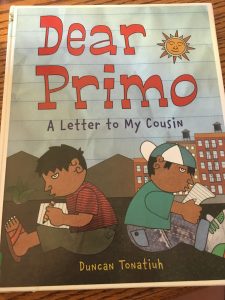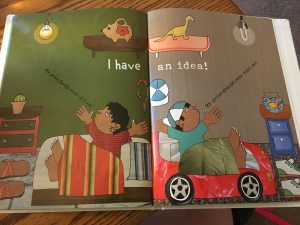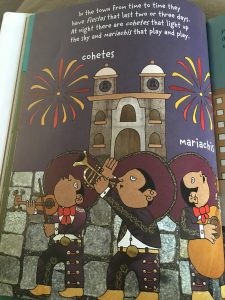
Author: Duncan Tonatiuh
Illustrator: Duncan Tonatiuh
Publisher and Year: Abrams Books for Young Readers, 2010
Number of Pages: 29
Genre: Realistic Fiction
Analysis: Dear Primo is a book about two cousins who live in different countries, one in America and the other cousin in Mexico. These boys write letters back and forth comparing the cultural differences in their own country. Dear Primo is also a 2015 Monarch Award Nominee.
This book could function as a mirror for other families whom are separated by country borders. Many families experience separation from one another and have some cultural differences within their family members. For families who are experiencing the same dilemma as Charlie and Carlitos, this book could function as a door because it could encourage them to write letters or communicate more with their families in other countries. However, this book could also function as a window for those who have family living in the same town or even same state because they could learn more about different cultures amongst families after reading this book.
Perceptually, the unique depictions of the characters on the front-page make the audience wonder what the book is about and curious if all the images will have a similar style as the drawings of the boys on the front. Once seeing the cover, the reader may want to dive into the book and read more about the culture seen. From the front cover, people who have learned about Spanish will recognize the word “primo” which means cousin in Spanish. This hint allows Spanish-speaking readers to know that this book will include the Spanish culture.
Structurally, the unframed images allow the audience to feel part of the action, experiencing the moments with Charlie and Carlitos. While reading the book, a reader may relate more to one cousin than the other. Within the book there are a couple pages that have similar instances portrayed with minimal differences. For example on the last page, which  is seen to the right, the boys are both in bed, but the differences of their shoes, lights, beds, shelves, tables and toys all vary based on the culture and country that the boys live in. The images throughout the book add to the words. Often times when Carlitos is writing he will include words in Spanish, so the images help the reader to understand the meaning of those few Spanish words.
is seen to the right, the boys are both in bed, but the differences of their shoes, lights, beds, shelves, tables and toys all vary based on the culture and country that the boys live in. The images throughout the book add to the words. Often times when Carlitos is writing he will include words in Spanish, so the images help the reader to understand the meaning of those few Spanish words.

The book ideologically portrays some important lessons about family and culture. The value of family can be seen throughout this book by the letters that Charlie and Carlitos write to each other. The boys care for one another and value the differences within their culture. Even though the cultural differences exist, the boys still love and respect one another. The differences are what make the family special in their own way. This book teaches others about a new culture and some basic language that children may be able to use. The lessons throughout this book are beneficial, informational and intriguing.
